The world of beekeeping, no matter where you reside, was once a simple passion that has evolved into a complexity that at times leaves us wondering which actions and what equipment we need to be successful. This evolution brought upon by economic interest, efficiencies, and new challenges often entices us to consider new methods. Amongst those colorful glossy catalogs’, products abound, each with a purpose and each with a required level of experience. Perhaps the newest consideration for addition to your equipment arsenal should be a Queen Castle. The castle is an affordable versatile piece of equipment, that pays for itself in a single-use and offers us, as beekeepers, security and options in our great apicultural adventures.
Beekeeping is a lifelong learning pursuit where Murphey’s law often prevails. We tell ourselves, what are the chances that an event will happen but have no choice other than to mark these occasions as education… leading to wisdom. We are indeed a wise group (double meaning here) but we all have come across times where queen failures, swarms, or multiple queen cells, or even wandering virgins entice our decision-making process. It can be a gut-wrenching feeling to watch our prize mated queen fly off into the great expanse upon an inspection, or worse yet, rolling her by accident. Things happen, but we can hedge our bets in some of these circumstances and profit from them instead of chalking up losses to learning.
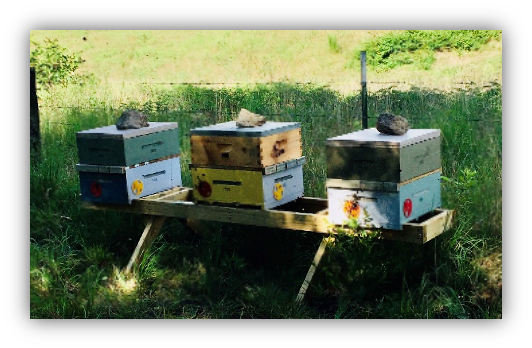
A queen castle (referred to a “castle” going forward) is a piece of beekeeping equipment that is a single unit but with multiple compartments nestled together where the compartments are separate. Think of a hotel, where different family units or visitors can dwell amongst each other in the same building but are separated by walls and have their own entry and pantry. It is a collection of several two or three frame nucs that share the same structure. So, what does this Queen Castle offer us? Here are some of the benefits that we will explore in greater detail.
Most manufactured queen castles utilize Hoffman frames sized to a Langstroth standard. They are usually deep brood chamber height in North America but can vary depending on the need of the beekeeper or what frame size(s) are used in an operation.
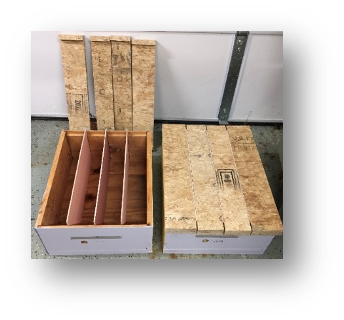
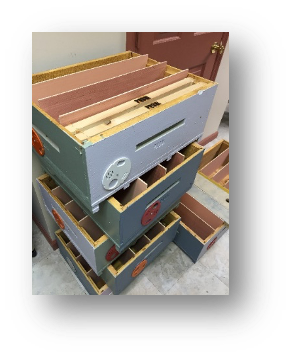
Castles are one unit and can vary by the number of compartments that they hold. Usually a 10-frame hive body, once remodeled, will offer three separate areas for three different colonies of bees to reside independently from each other. The compartments are separated by removable inner walls (think back to the hotel where you may have a room with a shared door to the adjacent room). This allows the beekeeper to remove an inner section, (like a follower board) if the colony needs more room and the adjacent apartment is vacant. The roof is unique in that the side walls jet up and offer a barrier so that each colony has its own separate cover. This aids in working one compartment at a time without bees checking out their neighbors. The floor, or bottom board, is different in that a foundation of wood supports the removable inner wall sections which butt up, offering colony exclusivity. The entrance is usually a single hole that can be regulated with the use of an entrance disk. Homemade versions can vary in the number of compartments or the number of frames as well. Finally, castles are usually divided into three frame sections (deep mostly) but can be found in configurations of two frames and even accommodating different frame heights.
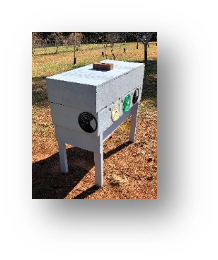
There are no absolutes in beekeeping. Mediums frame will also work if you purchase a deep queen castle as there is no reason why you cannot place medium frames in a deep height castle – the bees will usually draw comb below the bottom bar.
The beauty of a castle is its immense diversity. It may be used as a method to increase hive numbers, used as a mating nuc, or serve as a back-up repository for the aid of another failing colony. We can also remove resources and bolster up other hives, convert these small colonies to nucs, or even use them to hold mated queens. Plus, we do not need new equipment – something many of us either run short of or have too much of. To emphasize, these mini nucs are our safety or security resources for when we have a queen related need.
As mentioned, castles are two or three frame nucs where we establish an environment to allow a virgin queen to emerge, mate, or hold a mated queen. Ensuring that there are adequate resources, bees, and comb space will aid in success. Just like making a 5 frame nuc, the configuration is on a smaller/slimmer scale.
3 frame
1 Frame Capped Brood
1 Resource Frame (pollen and Nectar/Honey)
1 Empty Drawn Comb or Foundation Frame + Bees
2 frame
1 Frame Partially Capped Brood
1 Partially Filled Resource Frame
Generous Amount of Worker Bees
Castles are small and easily portable. They can be carried to new yards for replenishment or to support increases, easily hidden in the yard from neighborhood prying eyes, and are usually quick and easy to work since they contain a minimum number of frames per compartment. For mentors, they are an ideal teaching tool sue to the limited population of bees and the ease to show variations amongst colonies quickly. So how do we use them?…
There they are; all those beautifully capped swarm cells near the bottom bar or perhaps there are supersedure cells in multiples nestled amongst the comb further up the frame. Regardless if they are swarm or well-developed supersedure cells, these are resources for use. Hopefully most will develop into a queen as they mature and emerge presuming, they have had adequate resources and conditions, and were not previously slayed by an already emerged competitor. If we do nothing, we chance that many of these emerged virgin queens may take flight draining our bee population as they may cast off. The feeling of culling queen cells also has its detriment. So why not take advantage of the situation and produce some more viable queens that we may need in the future or we can help other beekeepers?
The process is elementary. Take the entire frame with the healthy robust queen cell and place it in your castle. Add resources, bees, and an empty frame. Keep the compartment filled with bees and place the cover on. The colony will need adequate ventilation and should be placed at a minimum in partial shade. Sometimes we find multiple queen cells on a frame and the use of an isolation cage or pin cage over some of the queen cells will preserve the emerging queens without cutting out, potentially damaging multiple cells on a frame. Just three queen cells will fill all three compartments of a castle. The investment and risk is minimal as locally produced queens are considered desirable.
Many of us have had that unique experience where a colony swarmed. It’s one of those things where we either knew it swarmed or were unaware that our queen and her daughters took a one-way vacation. Sometimes, serendipity or just luck plays a role enticing us to inspect that hive. Upon inspection you may witness queens emerging or see multiple virgin queens running the comb. What an opportunity!
If we have a castle, we can take a generous frame of bees, one of the virgin queens, offer a resource frame and an empty drawn comb or frame of foundation, and create a quick mating nuc. Just like with a queen cell method above, make sure there is a good population of bees and place them in their compartment. Again, adequate ventilation is key and considering “locking” them in for a day or two if you are keeping your bees in the same yard. This allows the bees to acclimate to their new home and reduces the number of older bees returning to the original hive. If you have an opportunity, move this queen castle to a new location to eliminate the lockdown. If you find multiple virgin queens or hear that wonderful crackling sound of queen cell caps being cut, take advantage of the opportunity. Now there could be additional queens for late-season splits, replacement of queen failures, and so much more. It’s a financial gain and will reduce the stress of sourcing a queen during a challenging time.
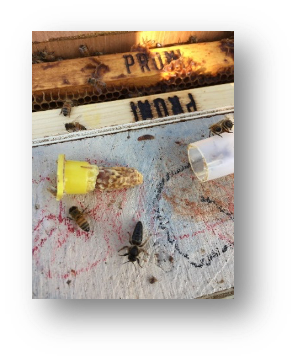
With virgin queens, and with queen cells – feed the compartment. Be patient and give the virgin queen a good 10 days to mature, mate, and then check on her progress. Look for eggs, larvae, pattern, and ensure the bees have enough space as they will require more real estate quickly. Should they run out of space simply remove a resource frame, shake off the bees and replace that removed frame with comb or foundation. Once you are pleased with the laying pattern, the prolific nature of the queen, and that she is laying worker bees, you can transfer these frames to a nuc or use this small colony as the replacement engine for a failing or queen issued colony.
In the commercial industry, many queen producers utilize mini-mating nucs. These are very tiny hives with limited amounts of bees designed for the exclusive purpose of queen mating. A queen cell that is close to emerging is installed, the virgin queen emerges, matures, mates, and then begins to lay. Afterwards her pattern and overall health is evaluated, and she is caged and begins a new path in life. The process repeats several times during the season until weather cools, resources limit, or pests or scavengers (wax moth, small hive beetle) invade.
The benefit of utilizing a queen castle in the same manner as a mini-mating nuc has many advantages. First, it utilizes existing frames from your apiary (brood pulls, bee populations, resources). Second, it requires no additional influx of investment and allows the beekeeper to return these frames back to full sized colonies after the season is complete or the needs of the beekeeper have been met. Castles are ideal for those who graft and produce their own queens as establishing and maintaining a mini-mating nuc can prove difficult and be a significant upfront equipment investment.
Castles can certainly work well in the same yard where beekeepers have their existing hives with a little bit of husbandry. When filling and placing a new castle in the same yard keep the bees contained in the castle for 48 hours. This reduces forager bees from returning to their original residence and accepting their new location as “home” during their isolation period. For those whose apiaries are far away, a castle is easily managed by vehicle transport and deposited at another location (preferably at least 2 miles away).
Great question, and the answer is dependent on region, but it can be a long shot. Three frame and four frame deep and medium castles have been successfully overwintered in North Carolina by the author. In warm southern US climates, it is more viable and unlikely in northern cold regions. Constant liquid feed is offered throughout the winter season and the castles are placed in a warm location. They can also be placed in a garage/basement or next to a south facing brick wall that absorbs heat. Wind breaks are beneficial and if kept indoors, your girls will appreciate the ability to have a cleansing flight on those warm days over 50 degrees F. Please note that some mortality is experienced, and it varies based on different winter temperatures, overall bee health, resources, and population – but it can be successful. During the summer months, the colonies can be transferred to nucs and built up. These nucs can be placed above a full-size hive for overwintering with increased odds of success. Again, it is a gamble but a chance to offset winter losses come spring.
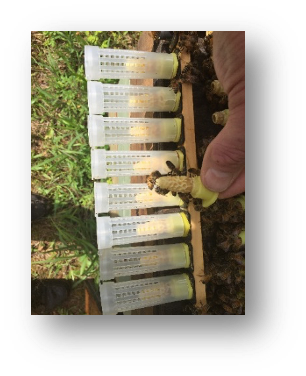
NO! We may be tempted to use our castle as a starter because of convenience or happenstance. There are not enough resources in a 2-3 frame nuc of establish the proper robust environment that a queen larva requires from a nutritional standpoint. Large populations of young bees, with generous resources are required to produce the most desirable queen cells.
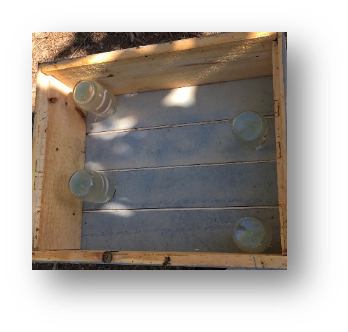
The decisions we have as beekeepers are many but somedays a simple investment into equipment can have a great pay off. Consider further investigating and adding a queen castle to your operation and witness the versatility, cost savings, and the nicety of having resources at a frame’s pull away. Regardless of hive style, all it takes is come carpenter wizardry – give it a try. Happy Beekeeping!
By Freddy Proni, former Véto-pharma North America Area Manager
Join the Véto-pharma community and receive our quarterly newsletter as well as our occasional beekeeping news. You can unsubscribe at any time if our content does not suit you, and your data will never be transferred to a third party!

© 2019-2024, Véto-pharma. All rights reserved